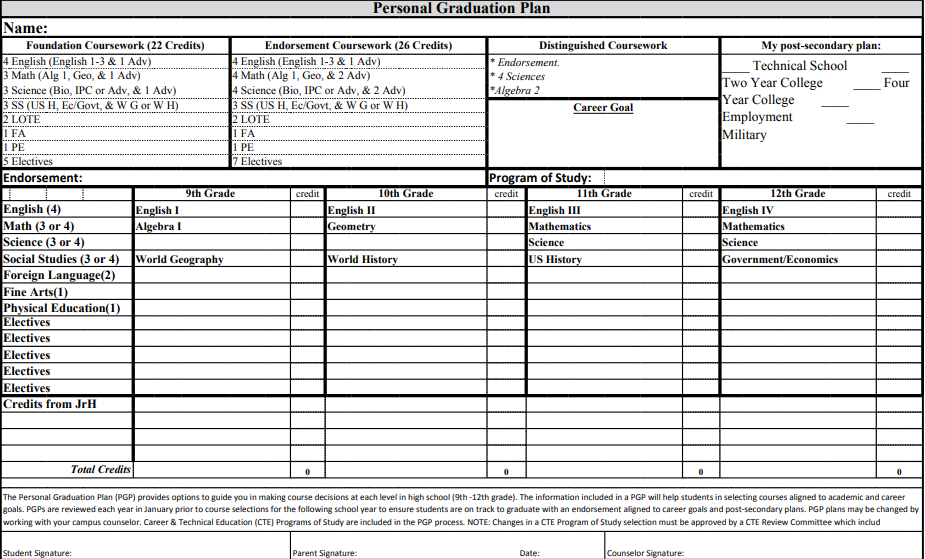
2023-24 Graduation Plan Layout
As part of a statewide initiative to better prepare students for life after graduation, Hallettsville High School has begun implementing the Texas “Pathway” requirement, a mandate aimed at improving college, career and military readiness.
Beginning with the 2024-25 school year, all high school students in Texas will be expected to complete four credits in a single career or technical education (CTE) pathway, as well as earn an industry-based certification (IBC) before graduation. The change marks a shift in how schools across the state—and students—are assessed for success.
From an administrative standpoint, the requirement is tied directly to how schools are evaluated by the state.
“High schools in Texas are graded on an accountability basis,” Principal Briscoe said. “That accountability is broken down by 40% of your STAAR scores, 40% of your CCMR scores (college, career, and military readiness) and 20% of your graduation rate. That’s where these pathways come in.”
Briscoe said that in previous years, STAAR scores made up nearly 80% of the school’s accountability score. With CCMR now making up almost half, the school’s ability to get students “future-ready” has become critical.
“The state is trying to make people either college-ready, career-ready, or military-ready,” Briscoe said. “And once you get that checkmark in high school by meeting one of those standards, that’s what gives you the CCMR point, that’s where the accountability piece comes in.”
To receive that CCMR point, students can follow multiple routes: high scores on college-readiness exams such as the SAT, ACT, or TSIA; enrollment in OnRamps or dual credit courses; or the completion of a CTE pathway that ends in an IBC test. For students who may not plan to attend a four-year university, the pathway option is one of the most accessible/realistic.
While this shift may benefit students in the long run, it also changes the purpose of high school education in the eyes of some educators.
“I think high school should be exploratory,” Briscoe said. “College is where you narrow things down. But at the same time, I feel for the kids going straight into the workforce with no skills; they’re kind of behind the eight ball. I don’t want them sweeping floors when they could be working on an engine, for example.”
The curriculum department has played a large role in adjusting district planning to meet the new requirements.
“The pathways came into play as part of a mandate from the Texas Legislature,” said Curriculum and Instruction Director Mandy Bucek. “It’s to help students who may not be college-bound earn certifications that can help them in their careers. There’s been a real focus on getting students ready for the workforce.”
Bucek said she’s seen the importance of CCMR grow across the state, especially as fewer students are attending four-year colleges.
“If we get students to have a checkmark that they qualify for CCMR in some way, then that increases our accountability rating drastically,” Bucek said. “STAAR scores matter, but CCMR is a huge portion of it now.”
She added that CTE pathways are just one of several ways students can achieve that readiness check, but for many students, they’re the most hands-on.
For those in the education and health science pathways, the shift has already become part of their everyday teaching.
“These classes are beneficial not only for students going into education but even for those just interested in learning more about child development or working with people,” HHS Counselor Brooke Mathews said.
Mathews said the pathway requirement has encouraged students to commit earlier to a potential career track. In her view, that’s not a bad thing.
“I think it prepares students to be more confident in their decisions after high school,” she said. “They’ll already have real-world experience. For education, that means being in classrooms and working with teachers and students.”
Still, she acknowledged the limitations.
“There are some students who start and realize education may not be for them, but at least they find that out now instead of later,” Mathews said. “And sometimes, it pushes students to stick with something just for the credit, which can be hard if they don’t love it.”
Similarly, students pursuing the health science pathway are getting a clearer look at what their future could involve.
“They start with Principles of Health Science, then move into Medical Terminology and Anatomy and Physiology,” HHS counselor Dena Strauss said. “By senior year, students who stay in the program can graduate with their Certified Nursing Assistant certificate.”
Strauss sees the pathway model especially useful for those unsure about attending college.
“If you’re going to jump into the workforce, at least this gives you a jumpstart,” Strauss said. “Healthcare workers are in high demand, and these students are ahead of the game when they leave high school.”
However, not every student fits neatly into a four-year pathway, especially those who transfer in or decide to change tracks.
“If a kid comes in halfway through, there are still other ways they can earn that CCMR point,” Briscoe said. “But if they don’t qualify through test scores or other programs, the pathway might be the only route.”
To accommodate more students, the school is now working to introduce CTE exposure earlier.
“We’re pushing some level one pathway courses down into junior high,” Briscoe said. “That way, students can test the waters before committing in high school.”
Despite the growing focus on specialization, Briscoe and Bucek both agreed that the true goal is to create more opportunity.
“I know it may feel like students are being asked to choose their future earlier,” Bucek said. “But they’re also being given more support and more tools to succeed; whether that’s in college or a career.”
For Briscoe, the intent is still student success above all.
“It has its benefits and its drawbacks,” he said. “But if it helps our kids walk out of here more prepared for real life, then it’s worth exploring.”